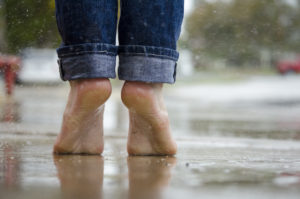What causes a Limb Length Discrepancy?
 LLD’s can be structural or functional in nature, or a combination of both.
Structural LLD’s describe a difference in the bone length of the femur or the tibia. This can result in a tilt at the hips and affect various joints and bones throughout the feet and legs, as well as the spine.
Functional LLD’s describe an apparent difference in length on standing because of biomechanical issues involving the way the muscles, connective tissues and jones function together. These occur even if the bone length of the tibia and femur are identical. It is often attributed to muscular contracture, particularly at the hips, as well as ligament laxity or tendon dysfunction that affects one foot more than the other.
LLD’s may be caused by:
LLD’s can be structural or functional in nature, or a combination of both.
Structural LLD’s describe a difference in the bone length of the femur or the tibia. This can result in a tilt at the hips and affect various joints and bones throughout the feet and legs, as well as the spine.
Functional LLD’s describe an apparent difference in length on standing because of biomechanical issues involving the way the muscles, connective tissues and jones function together. These occur even if the bone length of the tibia and femur are identical. It is often attributed to muscular contracture, particularly at the hips, as well as ligament laxity or tendon dysfunction that affects one foot more than the other.
LLD’s may be caused by:
- Developmental abnormalities
- Bone injury that results in healing in a shortened position, or injury to the growth plate during childhood
- Bone disease and infection
- Neurological conditions
- Inflammatory conditions affecting the joints
- Abnormal foot biomechanics
- Contractures of joints or connective tissues
- Ligament laxity
What are the symptoms?
Symptoms can vary greatly depending on the severity of the discrepancy and the resulting misalignment. This position of the bones, joints, muscles and connective tissues will determine what structures are overloaded, stressed, stretched and limited in their functional capacity. Because of this, it is difficult to pinpoint precise symptoms, but may generally include:- Altered gait patterns such as limping
- Shorter steps on the affected leg
- Slower walking speed
- Uneven loading and pressure distribution between the legs
- Stress fractures
- Muscular strain and tendinopathies
- Hip pain
- Knee pain
- Back pain
How is a limb length discrepancy treated?
Treatment depends greatly on the severity of the discrepancy, the symptoms, your age, and the risk for future issues. If the LLD is small, asymptomatic and does not appear to cause concerns for the future, it may not require treatment. Conservative (non-surgical) treatment for those exhibiting symptoms may include:- Footwear modification, such as building up one shoe to bring the joints of the lower limbs into alignment
- Orthotics to correct any biomechanical abnormalities contributing to the LLD and help bring the limbs into alignment with one another
- Stretching and strengthening tight or weakened muscles to help improve biomechanical function








